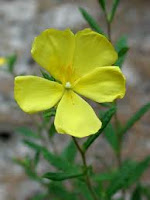There are around sixty tamarisk trees (farash in Urdu) in the world, and the two I have chosen to write about are the French tamarisk tree which is a native of the Mediterranean region and the one that is indigenous to the Middle East , North Africa and the Indian subcontinent and Sri Lanka . The latter is the tallest in the genus- Tamarix aphylla.
Writing in the 17th century the English herbalist, Nicholas Culpeper describes the T. gallica in this way:-
“The Tamarisk never grows to be a tree of any great bigness in England , though beyond the seas it will; having a rough dark brown bark. The younger branches are of a chestnut colour, cloathed with very fine tender green leaves, somewhat like those of cypress, but thinner and finer, and not at all hard or rough; the flowers grow in rough spikes at the ends of the younger shoots, an inch or more in length, several spikes growing together, each consisting of a great many small, five leaved, pale red flowers, which are succeeded by small seed, included in a downy substance.”
 |
| T.gallica |
He believed that the tree was from Spain because it is generally thought that the word tamarisk comes from the name of a Spanish river , the Tamaris.
The tamarisk trees are unusual in that they produce a substance called manna, although there is some debate as to whether this is produced by the tree in response to attacks by insects, or whether the sticky sweet substance is produced by the insects. Some say the tree is the source of the Biblical manna which the Israelites of the Bible (Exodus) were sent by God. However this is strongly refuted by many clerics.
 |
| T. gallica |
The French tamarisk has been used for its astringent qualities, and notably the galls contain 40 per cent tannin, so it has been used to treat diarrhoea and dysentery, to staunch the flow of blood from wounds and speed up the healing process, and as a laxative. It also has antimicrobial properties, so is good for cleaning wounds.
Extracts have been found to have a positive effect on the liver’s functioning and it seems that the tree possesses anti-inflammatory properties, as traditionally it has been used externally to bring relief from the pains and swellings of rheumatism.
 |
| T. aphylla |
This is what Nicholas Culpeper wrote about it in his 17th century Herball:-
“Government and virtues. A gallant Saturnine herb it is. The root, leaves, young branches, or bark boiled in wine, and drank, stays the bleeding of the hæmorrhodical veins, the spitting of blood, the too abounding of women's courses, the jaundice, the cholic, and the biting of all venomous serpents, except the asp; and outwardly applied, is very powerful against the hardness of the spleen, and the tooth-ache, pains in the ears, red and watering eyes. The decoction, with some honey put thereto, is good to stay gangrenes and fretting ulcers, and to wash those that are subject to nits and lice. Alpinus and Veslingius affirm, that the Egyptians do with good success use the wood of it to cure the French disease, as others do with lignum vitæ or *guaiacum; and give it also to those who have the leprosy, scabs, ulcers, or the like. Its ashes doth quickly heal blisters raised by burnings or scaldings. It helps the dropsy, arising from the hardness of the spleen, and therefore to drink out of cups made of the wood is good for splenetic persons. It is also helpful for melancholy, and the black jaundice that arise thereof. The ancients believed that swine which fed out of a trough made of this wood, would have no milk. The bark is sometimes used for the rickets in children.”
* lignum vitae comes from Guaiacum officinale. |
| T. aphylla |
The small branches and leaves have astringent and diuretic properties and externally a compress of the leaves and twiglets will staunch bleeding.
As for Tamarisk aphylla, it possesses similar medicinal properties and the flower galls are used in traditional medicine for their astringent properties and as a gargle. A decoction of the bark is used for eczema and other skin complaints.
 |
| T. aphylla |
This tree is a good firebreak as it has such a high saline content, so much so that it kills all vegetation which might try to grow under it, and its leaf litter contains so much salt that it doesn’t burn.
Both trees are used to help to prevent soil erosion because of their deep root systems. They do not take well to trimming however and so are not ideal for a garden hedge.
Dyes can be made from the galls on the tree, and the wood may be used in general construction, but it is not very strong, and is knotty.
These are interesting trees which I have found useful to sit under in the shade they provide on Greek island beaches.


















